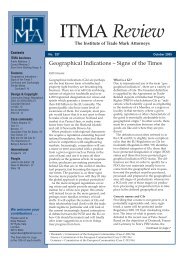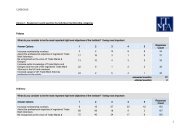ITMA 322 APRIL 2005
ITMA 322 APRIL 2005
ITMA 322 APRIL 2005
Create successful ePaper yourself
Turn your PDF publications into a flip-book with our unique Google optimized e-Paper software.
Features<br />
What’s in a Brand? Brand Valuation<br />
Neil Coulson<br />
“Groupe Danone is recognised for the dynamism and<br />
strength of its brands”<br />
(www.danone.com)<br />
“We cherish our brands; we are creative and courageous in<br />
pursuing their full potential”<br />
(www.diageo.com)<br />
Brands are big business. Brand owners recognise that<br />
much of the value of their company exists in their<br />
brands and their intangible assets. According to<br />
research undertaken by PricewaterhouseCoopers,<br />
intangible assets and goodwill accounted for up to<br />
74% of the average purchase price of companies in<br />
20031 .<br />
The trade mark<br />
Most brands are protected and underpinned by registered<br />
trade marks and the trade mark itself is a valuable<br />
asset, forming part of the wider concept of intangible<br />
assets or “brand value”. The value of the brand<br />
to a company will be reflected not just in its trade<br />
mark portfolio, which is vital as the base unit of protection,<br />
but also in less easily quantifiable terms such<br />
as market perception and positioning. The two exemplars<br />
quoted above, Diageo and Groupe Danone,<br />
advertise on their websites that not only do they protect<br />
of their brands — both will have extensive portfolios<br />
with sophisticated, proactive management — but<br />
also that they look to extend their brands to their full<br />
value and potential. Their approach is typical of all<br />
successful brand-owning companies. To do this effectively,<br />
though, companies need to quantify the<br />
abstract concept of the brand. This enables effective<br />
management, development and the addition of corporate<br />
value.<br />
Trade marks are vital for the protection of brand<br />
value and, almost invariably, brand development will<br />
centre on promotion of the trade mark or marks<br />
(which may or may not be the name of the product)<br />
in the mind of the consumer. The role of the trade<br />
mark arises from its very nature. Its function is to distinguish<br />
the goods or services of one undertaking<br />
from those of other undertakings, thereby indicating<br />
the origin of those goods or services to the consumer.<br />
The market distinction created by a strong trade mark<br />
by which the consumer recognises the brand underpins<br />
the performance of the brand (as a general concept)<br />
in national and international markets.<br />
Brand reputation<br />
The value of a brand depends to a large extent on its<br />
reputation, which is important both offensively in the<br />
generation of sales (and perhaps expansion into new<br />
markets) and defensively in the protection of the<br />
brand from encroachment by third parties. In litigation<br />
to protect investment in a brand, either for trade<br />
mark infringement or passing off, reputation can play<br />
a key role. Indeed, in a passing off action, reputation<br />
is the first requirement of Lord Oliver’s classic trinity<br />
of reputation, misrepresentation and damage that he<br />
set out in the Jif Lemon case. Active management of<br />
the brand contributes to the strengthening of this reputation.<br />
Brand valuation<br />
So we have the trade mark and we have established a<br />
reputation in the market. But how do the trade mark<br />
and other intangibles together create brand value?<br />
And how is it measured? Goodwill, market perception<br />
and position, pricing, quality — all these factors<br />
combine with a strong trade mark to drive the<br />
brand’s development and value. But, the presence of<br />
intangibles creates valuation questions beyond those<br />
of valuing the trade mark per se. They are, after all,<br />
“intangibles”. Why should you value your brand?<br />
How can it be done? What impact does the brand<br />
value have on the brand owner’s business?<br />
Specialist valuation groups in accountancy and<br />
finance practices offer brand valuation services.<br />
Indicators of brand value can be derived from the cost<br />
of creation of the brand (including the cost of development<br />
of the trade mark, although this generally<br />
bears little relation to current value); comparative<br />
market analysis; royalty streams (actual or potential)<br />
and economic use. All are useful indicators, none on<br />
its own provides the complete answer and, as we are<br />
dealing with intangible assets, there will always be a<br />
certain degree of value judgment. However, as precise<br />
a valuation as possible provides key information for a<br />
company’s internal management of its brands and in<br />
its external relations with its shareholders and potential<br />
investors. Further, as its brands can be a company’s<br />
main assets, an accurate valuation is essential for<br />
the purposes of a merger or acquisition. The concept<br />
of brand value in general and quantification of it<br />
needs to be communicated to a company’s internal<br />
and external market.<br />
Active and effective brand management<br />
Key performance indicators assist in a valuation<br />
process and provide effective management tools for a<br />
company’s brand team. Advertising and promotion<br />
constitutes a large proportion of spend and a correlation<br />
of the amount spent on advertising and promotion<br />
to overall brand value can facilitate a precise<br />
evaluation of the success or otherwise of the advertising<br />
and promotional activity to the brand value. This<br />
in turn can drive budget allocation, but above all it<br />
means that advertising and promotional spend is seen<br />
as an asset value rather than simply an expense cost.<br />
External market analysis of the impact of either specific<br />
campaigns or corporate advertising in general on<br />
brand value (most likely to be measured through<br />
sales) contributes valuable data to the brand manager<br />
and this data can be converted into financial informa-<br />
Continued on page 10<br />
December <strong>2005</strong> <strong>ITMA</strong> Review 9
















